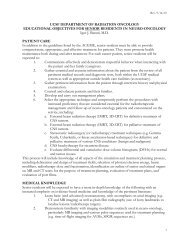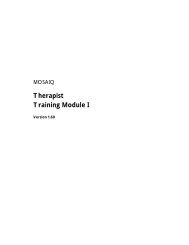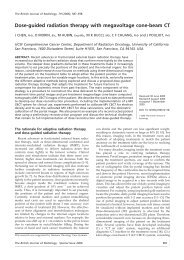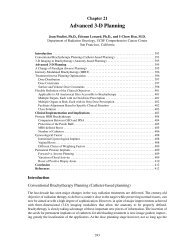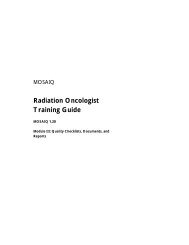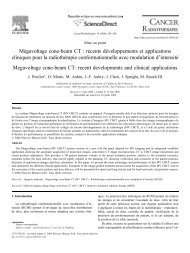Soft Tissue Visualization Using a Highly Efficient Megavoltage Cone ...
Soft Tissue Visualization Using a Highly Efficient Megavoltage Cone ...
Soft Tissue Visualization Using a Highly Efficient Megavoltage Cone ...
Create successful ePaper yourself
Turn your PDF publications into a flip-book with our unique Google optimized e-Paper software.
(a): 0.025cGy receptor 1 (b): 0.035cGy receptor 2<br />
3.2 Reconstructed Images<br />
3.2.1 Phantom Images<br />
Figure 3: QC-3V phantom images<br />
Figure 4 shows the QUASAR and contrast/spatial resolution (ball) phantom images that were acquired<br />
with receptor 1. The total delivered dose was 18cGy and no preprocessing filtering used. From Figure<br />
4(a) 2% electron density variation between acrylic and trabecular bone is resolvable without applying<br />
the adaptive filtering. Applying the resolution/dose adaptive filter will reduce the standard deviation in<br />
pixel intensities by a factor of ~0.5. <strong>Using</strong> the ratio of pixel intensity difference (due to density<br />
difference) to root mean square uncertainty in pixel intensities of receptor 1, it can be estimated that<br />
the receptor 2 due to its higher CNR compared to receptor 1 and in combination with preprocessing<br />
adaptive filtering is capable of resolving 1% contrast with radiation doses as low as 10cGy.<br />
The left image on figure 5 illustrates that muscle insert with contrast of 0.5% is resolvable with<br />
receptor 1 using 163cGy dose and without applying dose/resolution adaptive filtering. By using only<br />
the odd projections used for the previous reconstruction (163cGy) that corresponds to the dose value of<br />
81.5cGy (center image of figure 5), the 0.5% contrast is still detectable. The right hand image of figure<br />
5 shows that the minimum required dose in which the 0.5 % contrast becomes discernible with<br />
receptor 1 and by applying the adaptive filter is ~41MU (threshold of detection of 0.5% contrast). Note<br />
that all figure 5 images have the cupping artefacts that are due to the scattered, and no scatter/beam<br />
profile corrections have been applied to these images.<br />
Figures 4(b) and 6(a) illustrate that the 2mm air holes and gold seeds implanted (1mm x 3mm) within<br />
a head phantom are resolvable.<br />
Figure 6 (a) shows axial, coronal and sagittal images of a head phantom that is acquired with receptor<br />
2 by delivering only 1cGy. Figure 6 (b) displays the raw image (no adaptive filtering) of the 2D<br />
projection of this phantom acquired with 0.005cGy. The mean/standard deviation (SD) ratios of this<br />
2D projection (on open field regions) before and after applying dose/resolution adaptive filter are 26<br />
and 68, respectively. This indicates the possibility of the use of receptor 2 for 4D-CT.




